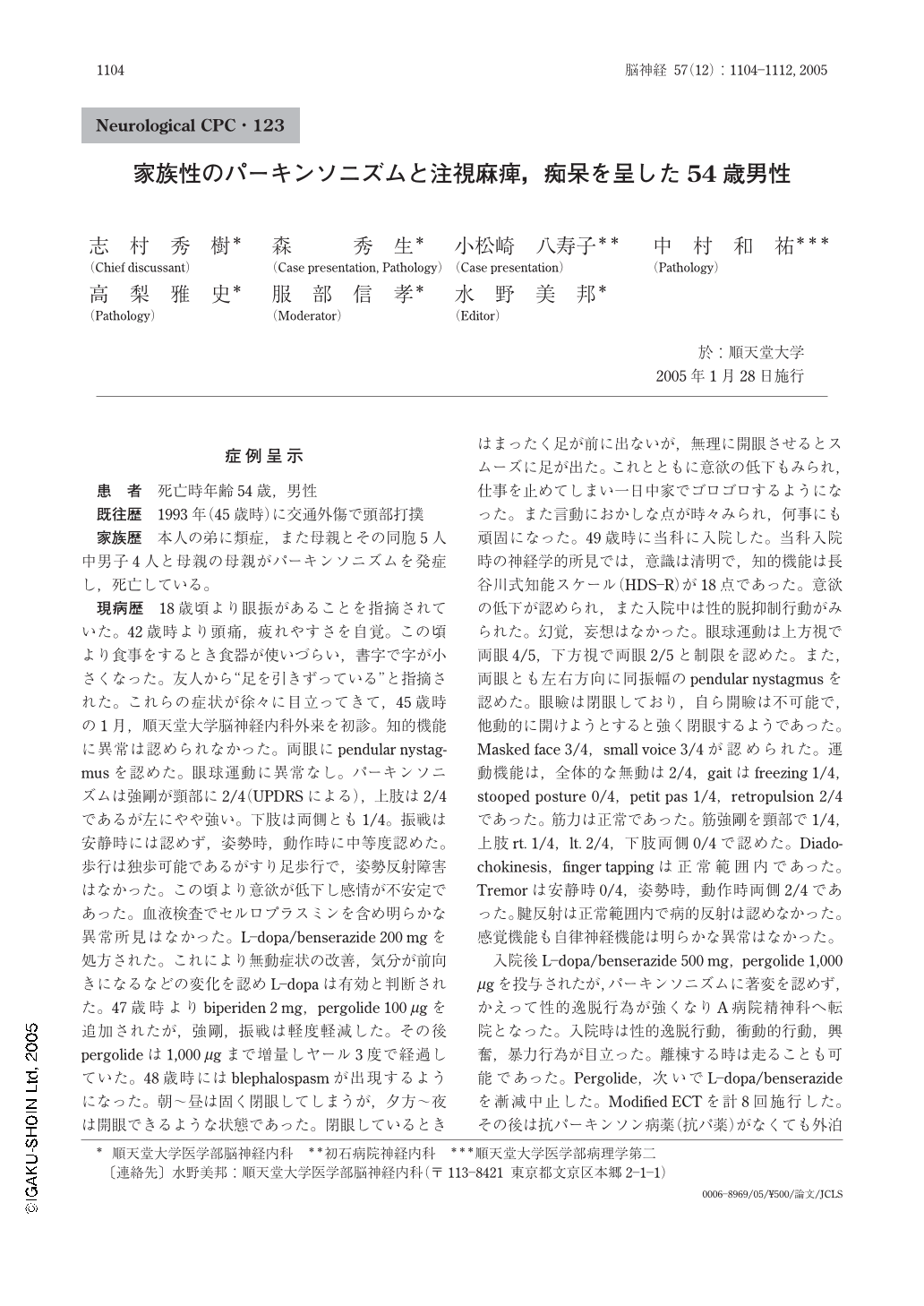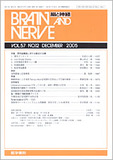Japanese
English
- 有料閲覧
- Abstract 文献概要
- 1ページ目 Look Inside
症例呈示
患 者 死亡時年齢54歳,男性
既往歴 1993年(45歳時)に交通外傷で頭部打撲
家族歴 本人の弟に類症,また母親とその同胞5人中男子4人と母親の母親がパーキンソニズムを発症し,死亡している。
現病歴 18歳頃より眼振があることを指摘されていた。42歳時より頭痛,疲れやすさを自覚。この頃より食事をするとき食器が使いづらい,書字で字が小さくなった。友人から“足を引きずっている”と指摘された。これらの症状が徐々に目立ってきて,45歳時の1月,順天堂大学脳神経内科外来を初診。知的機能に異常は認められなかった。両眼にpendular nystagmusを認めた。眼球運動に異常なし。パーキンソニズムは強剛が頸部に2/4(UPDRSによる),上肢は2/4であるが左にやや強い。下肢は両側とも1/4。振戦は安静時には認めず,姿勢時,動作時に中等度認めた。歩行は独歩可能であるがすり足歩行で,姿勢反射障害はなかった。この頃より意欲が低下し感情が不安定であった。血液検査でセルロプラスミンを含め明らかな異常所見はなかった。L-dopa/benserazide 200mgを処方された。これにより無動症状の改善,気分が前向きになるなどの変化を認めL-dopaは有効と判断された。47歳時よりbiperiden 2mg,pergolide 100μgを追加されたが,強剛,振戦は軽度軽減した。その後pergolideは1,000μgまで増量しヤール3度で経過していた。48歳時にはblephalospasmが出現するようになった。朝~昼は固く閉眼してしまうが,夕方~夜は開眼できるような状態であった。閉眼しているときはまったく足が前に出ないが,無理に開眼させるとスムーズに足が出た。これとともに意欲の低下もみられ,仕事を止めてしまい一日中家でゴロゴロするようになった。また言動におかしな点が時々みられ,何事にも頑固になった。49歳時に当科に入院した。当科入院時の神経学的所見では,意識は清明で,知的機能は長谷川式知能スケール(HDS-R)が18点であった。意欲の低下が認められ,また入院中は性的脱抑制行動がみられた。幻覚,妄想はなかった。眼球運動は上方視で両眼4/5,下方視で両眼2/5と制限を認めた。また,両眼とも左右方向に同振幅のpendular nystagmusを認めた。眼瞼は閉眼しており,自ら開瞼は不可能で,他動的に開けようとすると強く閉眼するようであった。Masked face 3/4,small voice 3/4が認められた。運動機能は,全体的な無動は2/4,gaitはfreezing 1/4,stooped posture 0/4,petit pas 1/4,retropulsion 2/4であった。筋力は正常であった。筋強剛を頸部で1/4,上肢rt.1/4,lt.2/4,下肢両側0/4で認めた。Diadochokinesis,finger tappingは正常範囲内であった。Tremorは安静時0/4,姿勢時,動作時両側2/4であった。腱反射は正常範囲内で病的反射は認めなかった。感覚機能も自律神経機能は明らかな異常はなかった。
入院後L-dopa/benserazide 500mg,pergolide 1,000μgを投与されたが,パーキンソニズムに著変を認めず,かえって性的逸脱行為が強くなりA病院精神科へ転院となった。入院時は性的逸脱行動,衝動的行動,興奮,暴力行為が目立った。離棟する時は走ることも可能であった。Pergolide,次いでL-dopa/benserazideを漸減中止した。Modified ECTを計8回施行した。その後は抗パーキンソン病薬(抗パ薬)がなくても外泊できる状態であった。この時の入院時の検査では,両側前頭葉・頭頂葉に部分的に血流の低下を認めた。MIBG心筋シンチグラフィーはH/M early 1.8,delay 2.1であった。50歳時,パーキンソニズムはUPDRSでturning in bed,walking,speech,facial expression,arisen from chair,gait,bradykinesiaで4/4であったが,L-dopa/benserazide 600mgでwalking,speech,facial expressionは2,他は1と改善した。その後再びB病院に転院,L-dopa/benserazideは漸減中止となっている。その後A病院に再入院,このときは無頓着で清潔が維持されない状態であった。また,性的逸脱行為が時折目立った。4月,抗パ薬が投与開始されシンメトレル(R)50mg/日投与されたがC病院に転院した。転院時は立ち上がり動作は速く,歩行も小刻みではないが姿勢反射障害が目立っていた。その他には垂直方向性の核上性眼球運動障害,頸部・体幹に強い筋強剛,開眼障害(開眼失行),眼振がみられていた。自発的に話すことはなく,応答はするが,small voice 3/4でほとんど聞き取れなかった。L-dopaの服薬時間とは関係なくon-offがみられ,on時は独歩可能で,off時は不可能であった。52歳時では,日によっては動ける時もあったが,無動の時間が長くなり,両手を持っての介助歩行もバランスが悪く倒れそうであった。車椅子に座っているが,急に立ち上がってしまうので転倒予防のため抑制帯が必要であった。翌年春頃はたまに応答して単文を話すことがあるのみであった。命令に応じて上肢を挙上することがあった。嚥下障害が進行し胃瘻(PEG)を造設した。臥床状態の時が多くなり,また左手はclaw handで背側骨間筋の筋萎縮もみられた。53歳時には,上肢を受動的に挙上させると挙上させたままの姿勢をとり続けるcatalepsy症状がみられていた。54歳で両側肺炎のため死亡された。
We report a Japanese man with familial parkinsonism who died at age 54. His younger brother, his mother, the mother's 4 brothers, and their mother were also affected with similar parkinsonism. The patient had had nystagmus since adolescence. He noticed difficulty in walking and micrographia at age 42. Neurological examination at age 45 in our hospital revealed pendular nystagmus, moderate rigidity in his neck and upper limbs, postural tremor in hands and shuffling gait. He received L-dopa/benzerazide 200mg and his movement was mildly improved. Then he developed forced closing of eyelids suggesting either blepharospasms or apraxia of eye lid opening. He became apathetic at age 48. He was admitted to our hospital at age 49. On admission, he showed mild dementia and sexually disinhibited behaviours. Moderate downward gaze palsy and rigidity were seen. Increase of L-dopa/benzerazide and pergolide did not improve his parkinsonism and his disinhibited behaviors became worse. L-dopa/benzerazide and pergolide were decreased and he received electroconvulsive therapy at a psychiatric hospital with temporally improvement in his movement. He became unable to walk at age 52 and he was mutic and bedridden. He died of pneumonia at age 54. The patient was discussed in a neurological CPC, and a chief discussant arrived at the conclusion that the patient had a familial form of dementia with Lewy bodies. Many participants thought that he had frontotemporal dementia and parkinsonism linked to chromosome 17. The pathological examination of his brain showed severe neuronal loss in the substantia nigra, subthalamus, and pallidum. Ballooned neurons were observed in the cerebral cortex. Immunohistochemistry using anti-tau antibodies revealed tau-positive neurons, glial cells and threads in the cerebral cortex, white matter and subcortical nuclei; these tau deposition reacted with an anti-4-repeat tau antibody, but not reacted to an anti-3-repeat tau antibody. Sequencing of genomic DNA of the patient showed a missense mutation in exon 10 of tau that caused a substitution at codon N279K. These neuropathological and molecular studies revealed the diagnosis of the patient was FTDP-17 with N279K mutation.

Copyright © 2005, Igaku-Shoin Ltd. All rights reserved.


